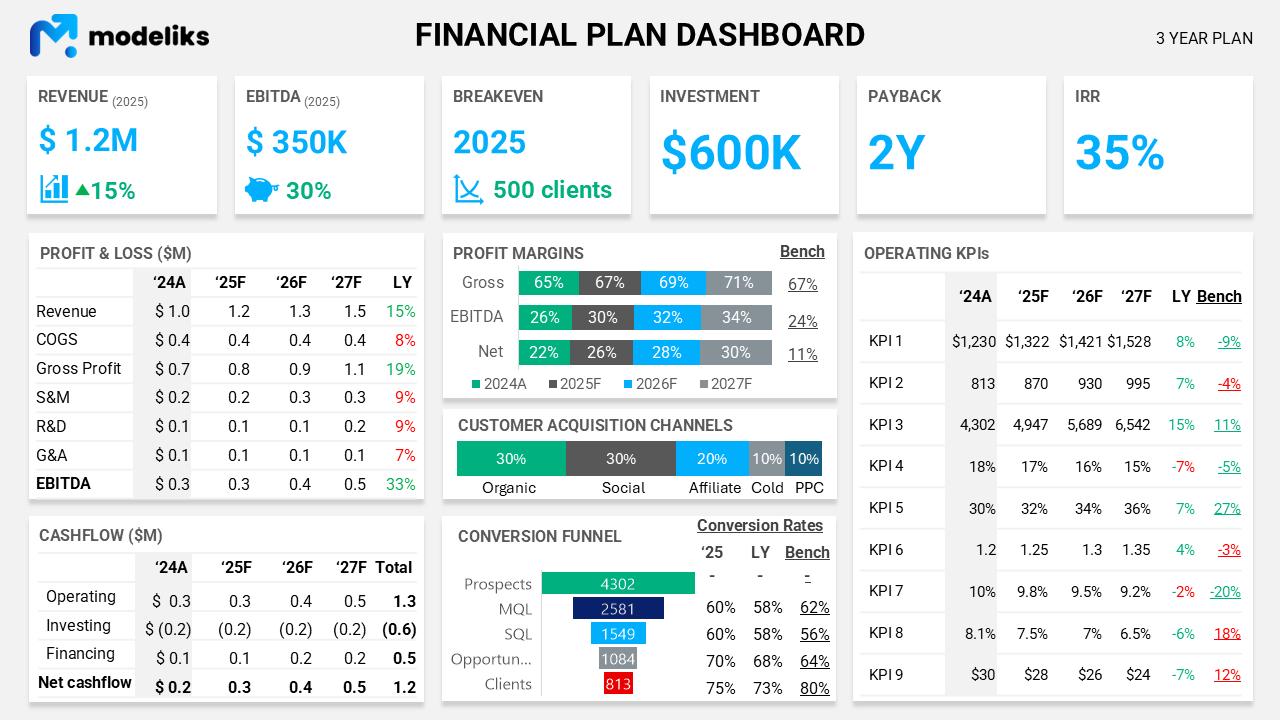Our Freight and Cargo Handling Financial Model Structure covers all the essential aspects you need to consider when starting or scaling a Freight and Cargo Handling business. By following this structure, you can better understand your revenue streams, costs, and assets, helping you optimize profitability and strategically plan for growth.
Freight and Cargo Handling Financial Model Structure
Financial planning is a critical aspect of running a successful Freight and Cargo Handling business. An effective Freight and Cargo Handling financial model helps you map out your business’s revenue channels, anticipate costs, understand staffing needs, and assess the assets you require to grow and succeed. Moreover, such a model can uncover new revenue opportunities, optimize profitability, and provide a clear view of your financial landscape. The Freight and Cargo Handling financial model structure is crucial; however, it also requires ongoing evaluation because markets shift. This complexity demands attention, although it may seem daunting at first.
Revenues
The revenue streams of a Freight and Cargo Handling business are diverse and can encompass various aspects:
- Freight Charges : Income generated by charging clients for transporting goods.
- Handling Charges : Fees associated with loading and unloading goods at shipping points.
- Storage Fees : Earnings derived from storing client goods in warehouse facilities.
- Customs Brokerage : Revenue obtained from assisting clients with customs documentation and procedures.
- Insurance Fees : Income earned from offering insurance for cargo protection.
- Consulting Services : Income from advising clients on logistics and supply chain management.
- Freight Consolidation : Charges incurred for combining smaller shipments to enhance transport efficiency.
However, the intricacies of these streams are often overlooked because they play a crucial role in the overall profitability of the business. This multifaceted approach not only maximizes revenue but also ensures a more streamlined operation.
Cost of goods sold
The cost of goods sold (COGS) for these revenue streams includes direct costs such as transportation expenses, handling labor costs, warehouse rental costs, equipment maintenance, and any third-party logistics provider fees. However, these expenditures can fluctuate significantly based on market conditions. Although essential, they can impact profit margins because of their variability. This complexity necessitates careful management.
Employees
Staffing is essential, and typical employees include:
- Logistics Coordinator : Manages transport schedules and communication with clients.
- Warehouse Supervisor : Responsible for overseeing warehousing operations and inventory management.
- Customs Broker : Handles documentation and compliance with customs regulations.
- Forklift Operator : Tasked with the loading and unloading of freight.
- Account Manager : Manages client relationships and new business development.
However, because each role is crucial, the effectiveness of the entire operation hinges on their collaboration.
Operating expenses
Common operating expenses include:
- Rent : The payment for office and warehouse facilities, which is a significant expense.
- Utilities : Costs associated with electricity, water, and gas, which are essential for operations but can accumulate quickly.
- Salaries and Wages : Compensation for all employees, reflecting the value of their work.
- Fuel Costs : Expenses related to vehicles used in transportation, which are necessary but can fluctuate based on market conditions.
- Insurance Premiums : Coverage for property, liability, and workers’ compensation, crucial for mitigating risks.
- Maintenance : Includes repairs for transportation and warehousing equipment, ensuring efficiency.
- IT and Telecommunications : Expenses incurred for communication systems and software, which enhance connectivity.
- Marketing and Advertising : Costs linked to promoting services, playing a vital role in growth.
- Office Supplies : Purchases needed for day-to-day operations, which can add up over time.
- Professional Fees : Payments for legal, accounting, or consulting services, often necessary for compliance and strategic planning.
Assets
Key assets for a Freight and Cargo Handling business include transport vehicles such as trucks and vans for moving goods; warehousing facilities—buildings for storing goods; handling equipment, such as forklifts and conveyors, for goods movement; and IT infrastructure, which consists of systems and software for managing logistics and operations. However, without these critical components, the efficiency of the business might decline, because each plays a role in the overall process.
Funding Options
Common funding options include: Bank Loans, traditional loans for capital and operational needs, are essential for businesses. Angel Investors, however, are individuals who invest personal capital in exchange for equity in the business. Venture Capital, on the other hand, involves firms that invest in return for equity, focusing on growth potential. Equipment Leasing offers a financing option that allows businesses to lease necessary equipment instead of purchasing it outright.
Driver-based Financial Model for Freight and Cargo Handling
A genuinely professional financial model for a Freight and Cargo Handling business is based on the operating KPIs (key performance indicators) relevant to the industry.
- Load Factor : The percentage of capacity used in transportation and storage.
- Turnaround Time : The time taken to complete a loading/unloading cycle.
- Fuel Efficiency : The distance covered per unit of fuel.
- On-time Delivery Rate : The percentage of deliveries made within the scheduled time.
- Storage Utilization : Measures the efficiency and effectiveness of warehouse space usage.
- Customer Satisfaction Score : Serves as a measurement of client satisfaction with services.
- Margin per Shipment : Reflects the revenue generated per shipment after direct costs.
Driver-based financial planning involves identifying crucial drivers that impact business results; it establishes relationships between financial outcomes and necessary resources such as people, marketing budgets, equipment, etc., and builds financial plans around these drivers. If you wish to know more about driver-based financial planning and why it is the right way to plan, see the founder of Modeliks explaining it in the video below.
Need a business plan?
Create one with Modeliks AI in the next hour!
AI powered business planning for Startups and SMEs.
The Financial Plan Output
The aim of the financial forecast outputs should enable you and perhaps your management, board, or investors to quickly comprehend how your Freight and Cargo Handling enterprise will perform in the future. You need to gain assurance that the plan is well thought out, realistic, and achievable. Additionally, you must understand what investments are necessary to implement this plan, as well as what returns on investment might be expected. To attain these objectives, here is a one-page template illustrating how to effectively present your financial plan.

Beyond this one-page summary of your plan, you will require three projected financial statements: a profit and loss statement, summarizing revenues, costs, and expenses over a period; a balance sheet, providing a snapshot of assets, liabilities, and equity at a specific point in time; and a cash flow statement, which records cash inflows and outflows during a particular period.
Freight and Cargo Handling Financial Model Summary
A professional Freight and Cargo Handling financial model summary will assist you in thoughtfully considering your business, identifying resources needed to achieve your targets, setting goals, measuring performance, raising funds, and making confident decisions to manage and grow your business. However, this process is essential because it underpins your strategic direction and operational success.
If you need help with your financial plan, try Modeliks , a financial planning solution for SMEs and startups or contact us at contact@modeliks.com and we can help.
Author:
Blagoja Hamamdjiev
, Founder and CEO of
Modeliks
, Entrepreneur, and business planning expert.
In the last 20 years, he helped everything from startups to multi-billion-dollar conglomerates plan, manage, fundraise, and grow.

TAKE MODELIKS FOR A SPIN
Not sure which plan?
Start with a 15 days free trial.
You will have access to the full functionality of Modeliks. The only restriction in the free trial is that you cannot download or share your business plan outside Modeliks. Credit card is not required to subscribe for the free trial.






